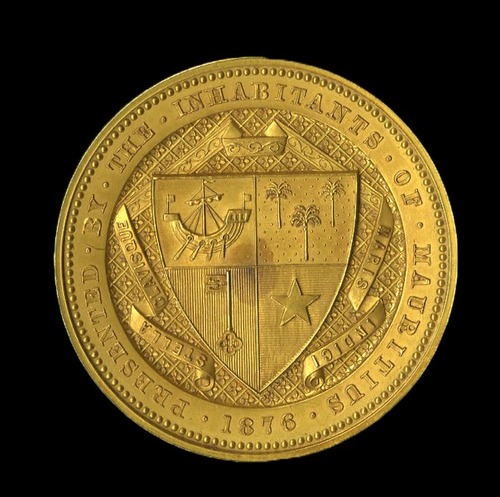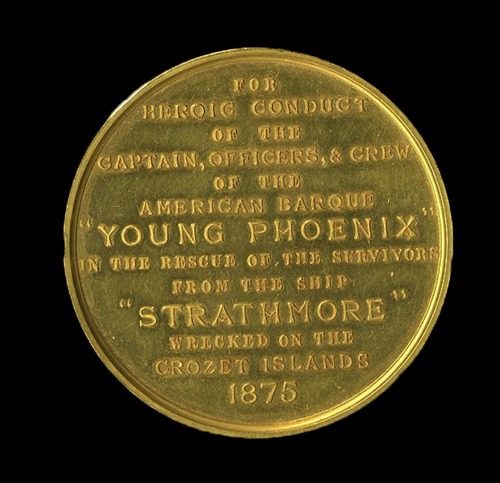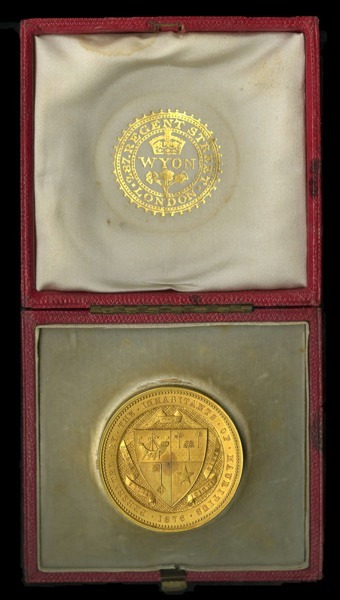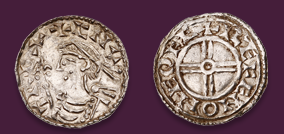Auction: 322 - The Numismatic Collector's Series Sale
Lot: 271
Great Britain, Mauritius Medal, 1876. Gold, 43mm. 2 ozt. Mauritius coat of arms center; rev. 'For Heroic Conduct of the Captain, Officers, & Crew of the American Barque "Young Phoenix" in the Rescue of the Survivors from the Ship "Strathmore" Wrecked on the Crozet Islands 1875.' Edge: 'MR F.C. SWAIN, CHIEF OFFICER'.
On April 17th, 1875, the Strathmore, a three-masted, fully-rigged British trading vessel, set sail from London bound for New Zealand with a total of 50 passengers, 38 crew members, and approximately 20,000 tons of gunpowder. The ship sailed south past the African continent and around the Cape of Good Hope, before setting a course directly east through the southern Indian Ocean.
In the wee hours of July 1st, amid dark and foggy weather, the Strathmore struck a rock near the Crozet Islands, a small archipelago in the Southern Indian Ocean nearly equidistant between South Africa and Antarctica. Robert Wilson, a passenger on the Strathmore, in his diary described this most tumultuous ordeal as follows: "July 1. Aroused from a sound sleep about a quarter to four this morning by the cry of 'beakers right ahead,' " hard a star-board,' dressed as quickly as possible and went on deck;`' all was darkness. and confusion, made my way aft, and heard the captain say, "There is no hope, we are all lost ,we are all lost".
Only 49 of the 88 individuals on board made it ashore. They spent the next three days salvaging cargo from the wreck until the ship was fully submerged, as well as constructing a signal tower to hopefully draw the attention of any passing ships. The weather was bitterly cold, with 2-3 inches of snow already on the ground when they landed. One man died their very first night on shore due to exposure. Vegetation of any kind was scarce, with the castaways surviving those first few months hunting albatross and gathering moss and lichens which they would flavor with gunpowder salvaged from the wreckage. Two other passengers died of dysentery and lockjaw respectively in the following months.
In September, the condition of the survivors drastically improved with the appearance of penguins which arrived on the island in droves. Robert Wilson described the phenomenon this way: "September 20. - The first penguin landed and was killed this day. September 27. - During the past week the penguins have been landing in thousands. - I might say in millions with truth. No scarcity of food now. October 14. - Collecting thousands of penguin eggs before they go bad, but, owing to the prevalent inclement weather, we have left thousands to be hatched." Even with a steady food source and somewhat milder weather, two more passengers perished in December, one being a three-year old boy.
Finally on January 21st, 1876, after nearly seven months shipwrecked, the passengers spotted a ship sailing towards them, the signal tower evidently having done its job. The ship proved to be an American whaler, the Young Phoenix from New Bedford, Massachusetts. The barque dropped anchor and a team of sailors boarded lifeboats and rowed toward the island to greet the castaways. After some deliberation over concerns about the size of the group of shipwrecked passengers, the captain and crew of the Young Phoenix allowed all 44 survivors to embark on the ship which was bound for Mauritius.
While at open sea, 20 passengers were transferred to the Sierra Morena, a British trading vessel bound for Karachi, India as there was not enough provisions on the Young Phoenix with 44 extra individuals on board. These 20 were dropped off at Pointe de Galle, Ceylon in February 1876 with some eventually returning to England and others travelling to Sydney, Australia. The rest of the 24 passengers still on board the Young Phoenix were dropped off in Mauritius in February 1876, and ultimately reached Auckland, New Zealand later that same year.
It is unknown how many of these medals were struck. There are at least 2 bronze medals known to exist, one of which is at the National Maritime Museum in Greenwich, UK, and this one struck in gold. It likely is safe to assume that there is also at least one other medal struck in gold, which would have been given to the Captain of the Young Phoenix. This medal offered here is a 'must have' for any advanced collection of Lifesaving Medals.
Housed in its original presentation box by Wyon, the famous family of medalists from London. Uncirculated, with a small area of light discoloration on the obverse. The reverse, as expected, shows some reflectivity due to this side of the medal laying against the velvet interior of the box. Very rare.
Sold for
$8,000

































